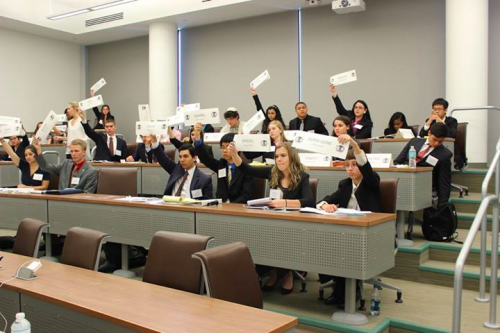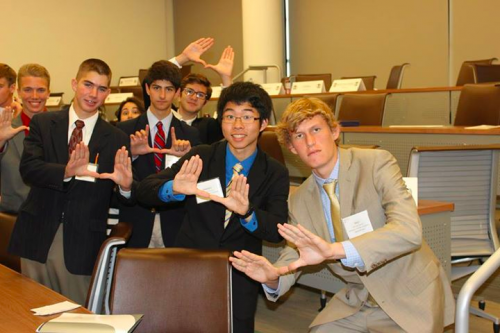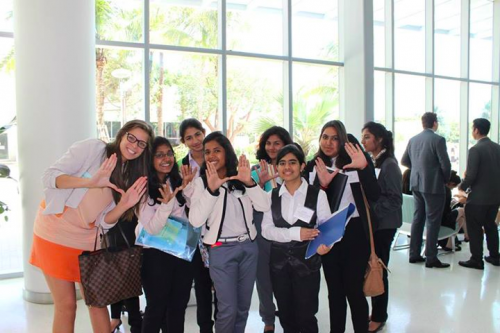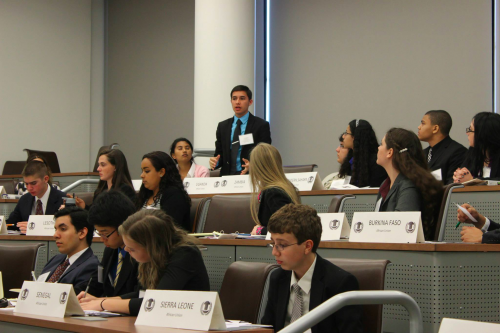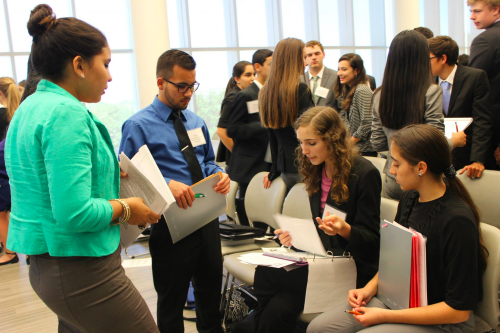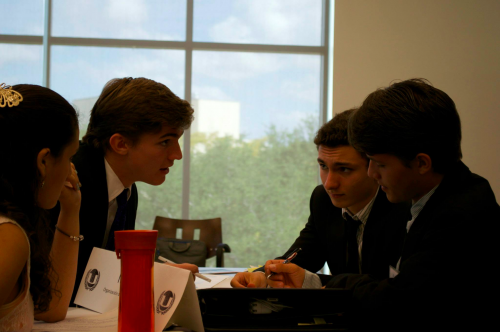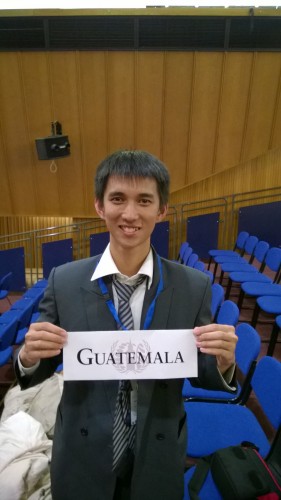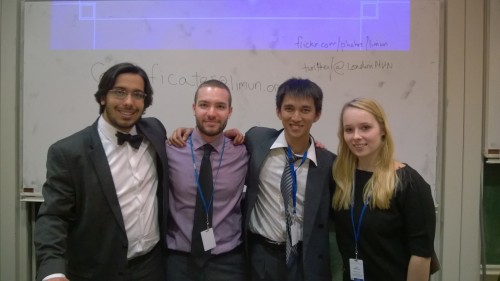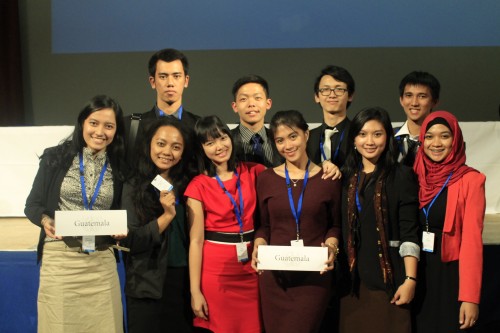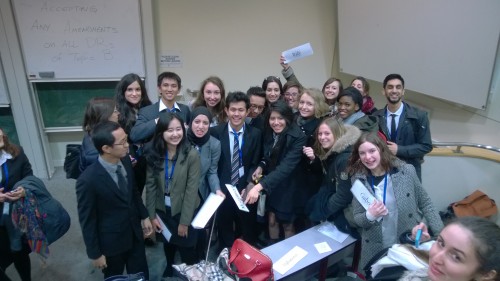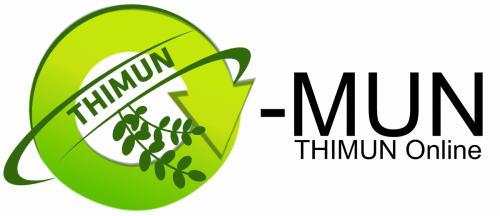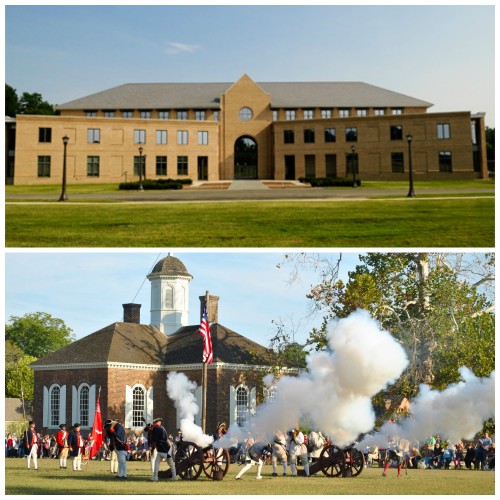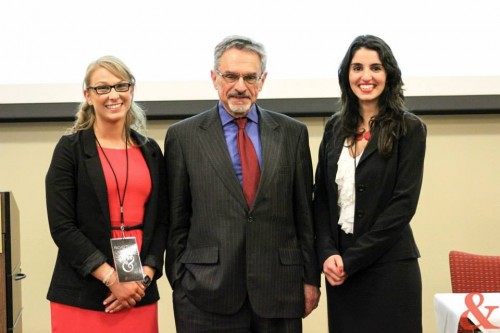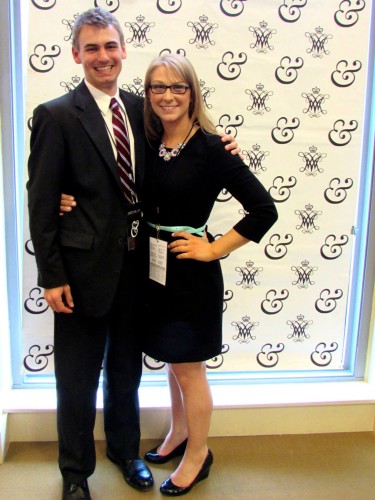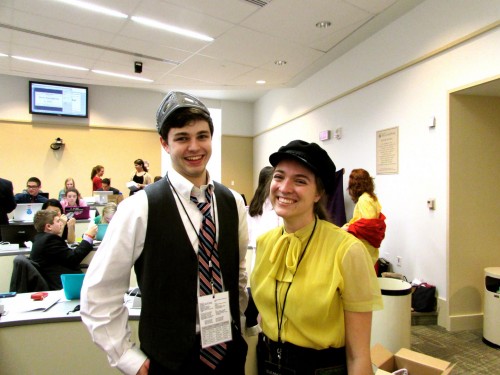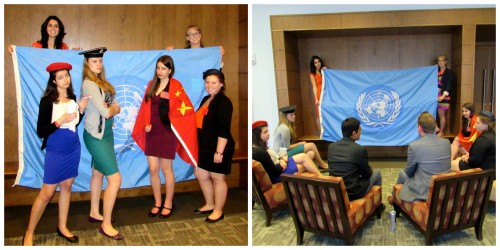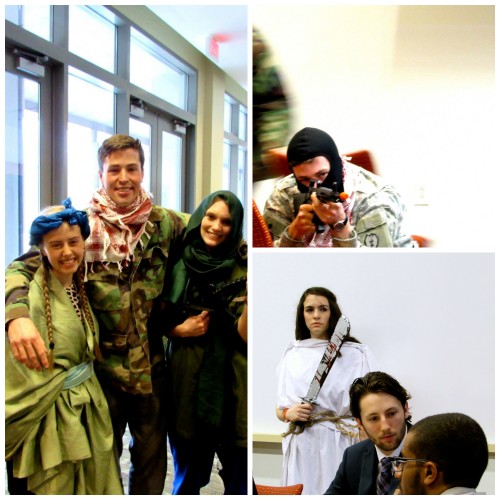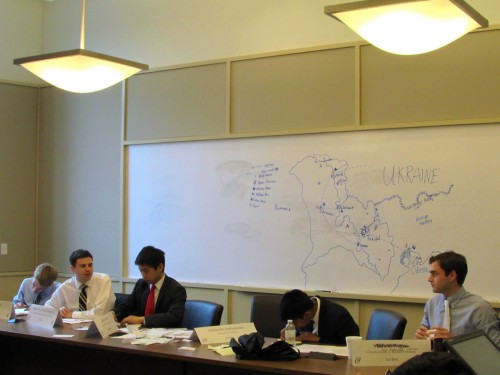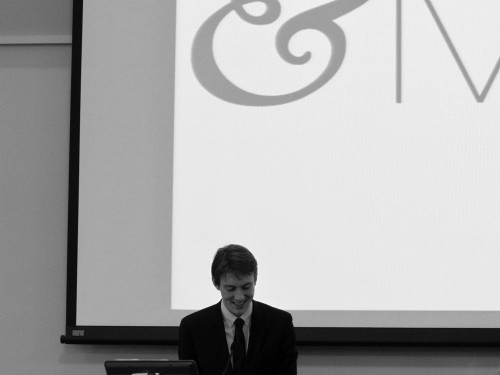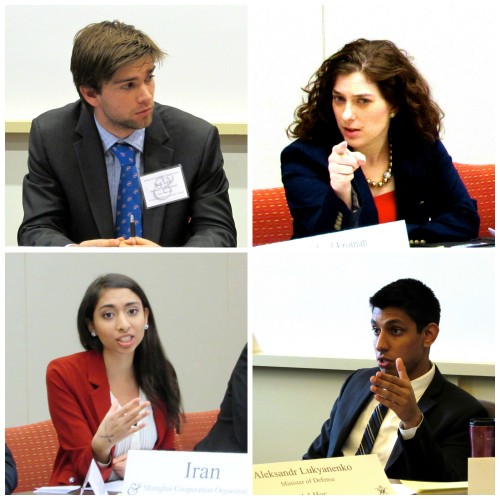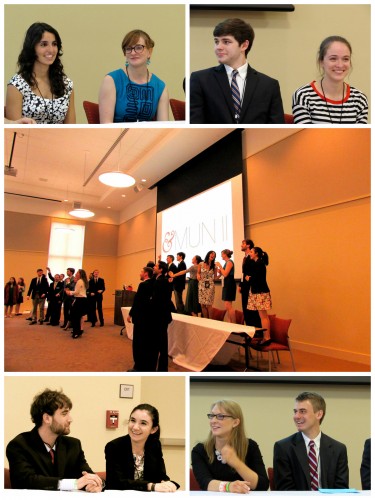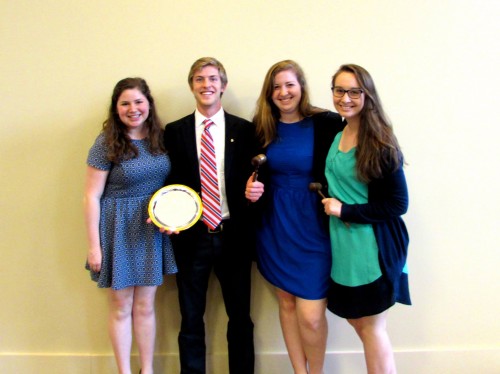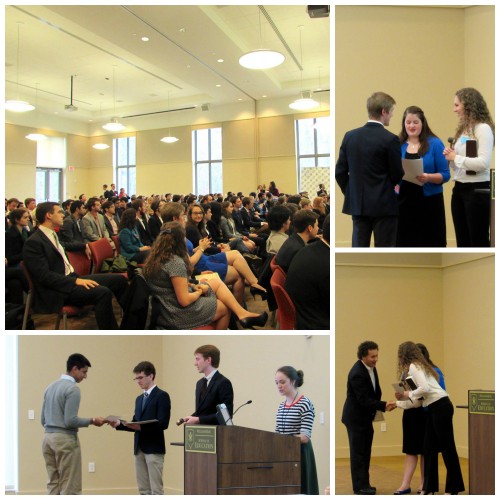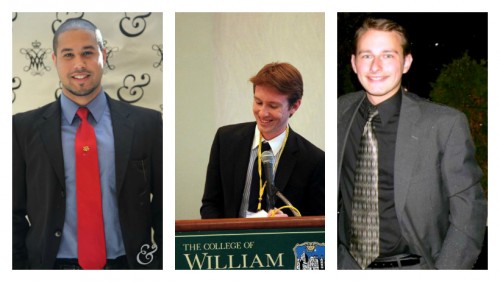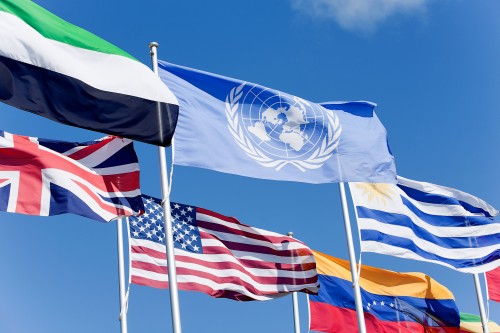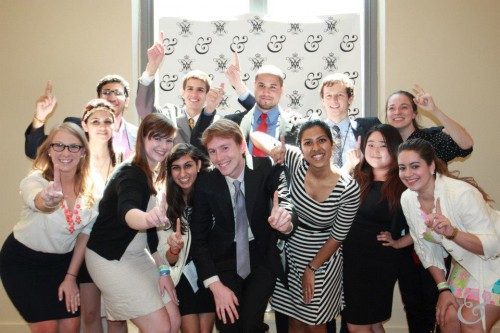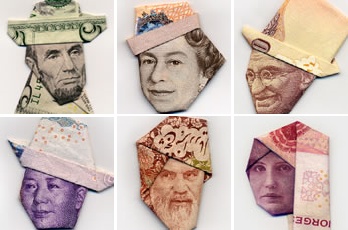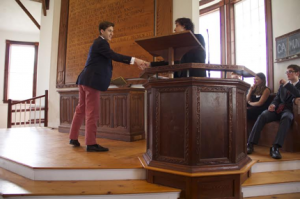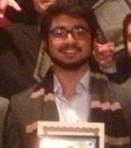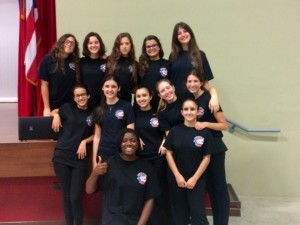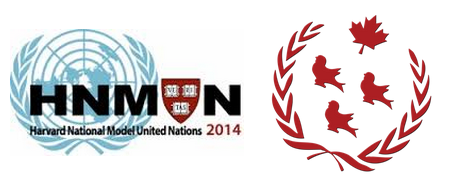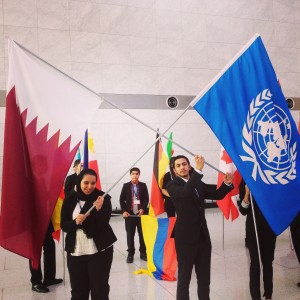![Screen Shot 2014-05-14 at 1.14.31 AM]()
Purpose: The purpose of the College Model UN All-Star Team is to recognize exemplary individuals in the college MUN community who have made a difference inside and outside of committee. These could be but are not necessarily limited to just the best delegates or award winners; conferences already determine those. Rather, the College MUN All-Star Team should be representative of the best and most respected leaders in the community. They are diplomatic and skilled in committee, help strengthen the relationships between schools, provide thought leadership, and make the Model UN experience better for everyone.
Process: College students who participated in at least one college Model United Nations conference in North America were eligible to submit one nomination form of up to ten students on the college circuit. Due to the All-Star Team’s emphasis on community, students were only allowed to nominate up to two delegates from their own school and were not allowed to nominate themselves. The nomination process took place from April 21-28 and was promoted to a wide range of universities by the Best Delegate Media team. Each nominated name received one vote. Ballots were manually edited for spelling inconsistencies and manually checked for validity; only votes from valid ballots counted in the final numbers. Delegates receiving the top number of votes were given All-Star team honors divided into three tiers that reflect the percentage of votes received: this year it was 11 First Team, 15 Second Team, and 16 Third Team.
Credits: Katherine Bonner served as project lead for spreading awareness of the nomination process and sourcing the biographies and photos, and she was assisted by Erik Leiden, Oliver Nacey, Ellen Perfect, and Ashley Rhoades. Thank you to all the individuals for contributing their peers’ biographies and thank you to everyone on the circuit for participating in recognizing their peers for leadership in the community.
All names are in alphabetical order within each tier. Biographies and photos are provided by the All-Star’s peers, typically a leader within the same team.
College MUN All-Star Team (First Team)
Anthony Mercado
Florida International University
![Screen Shot 2014-05-14 at 12.04.17 AM]() Anthony Mercado joined the FIU MUN team during the Spring 2013 semester. He served as Head Delegate and Assistant Program Director during the 2013-2014 year. Mercado received the Best Delegate award at five conferences including UPMUNC, ChoMUN, and UNCMUNC. He has recently accepted a job offer with AON and will begin working at the Miami office in early June.
Anthony Mercado joined the FIU MUN team during the Spring 2013 semester. He served as Head Delegate and Assistant Program Director during the 2013-2014 year. Mercado received the Best Delegate award at five conferences including UPMUNC, ChoMUN, and UNCMUNC. He has recently accepted a job offer with AON and will begin working at the Miami office in early June.
Apratim Gautam
University of Chicago
![Screen Shot 2014-05-14 at 12.04.31 AM]() Apratim Gautam originally hails from the quaint town of London, and is a rising fourth year at the University of Chicago. One of the head delegates of the team, Apratim was the CCD of the Court of the Jianquing and Ching Shih’s Red Fleet and a chair at ChoMUN last year, as well as having chaired for the last three years at the high school conference, MUNUC. In addition, Apratim was a part of the WEMUN Expo of 2012 and has had a series of exciting investment banking work experiences lined up for his summers.
Apratim Gautam originally hails from the quaint town of London, and is a rising fourth year at the University of Chicago. One of the head delegates of the team, Apratim was the CCD of the Court of the Jianquing and Ching Shih’s Red Fleet and a chair at ChoMUN last year, as well as having chaired for the last three years at the high school conference, MUNUC. In addition, Apratim was a part of the WEMUN Expo of 2012 and has had a series of exciting investment banking work experiences lined up for his summers.
Eric Wessan
University of Chicago
![Screen Shot 2014-05-14 at 12.13.21 AM]() President of UChicago Model UN, Eric is a graduating senior from the University of Chicago and is famous for his pastels and bowties. Eric has a formidable record and led the team to one to boot. Further, Eric has run three of the largest committees ChoMUN ever had, and also participated in MUNUC this year. Eric will be working in San Francisco this upcoming summer.
President of UChicago Model UN, Eric is a graduating senior from the University of Chicago and is famous for his pastels and bowties. Eric has a formidable record and led the team to one to boot. Further, Eric has run three of the largest committees ChoMUN ever had, and also participated in MUNUC this year. Eric will be working in San Francisco this upcoming summer.
Nina Chen
Harvard University
![Screen Shot 2014-05-14 at 12.23.34 AM]() Nina served as co-head delegate of the Harvard MUN team this past academic year. Having started Model UN only in college, Nina has shown unbelievably fast growth as a delegate and immediately became a commanding and strong delegate. Nina is also a particularly charming and kind individual who has made herself an integral part of Harvard’s team not only because of her abilities in committee but also because of the genuine friendships she has built with so many other team members.
Nina served as co-head delegate of the Harvard MUN team this past academic year. Having started Model UN only in college, Nina has shown unbelievably fast growth as a delegate and immediately became a commanding and strong delegate. Nina is also a particularly charming and kind individual who has made herself an integral part of Harvard’s team not only because of her abilities in committee but also because of the genuine friendships she has built with so many other team members.
Richard Ebright
Harvard University
![Screen Shot 2014-05-14 at 12.42.33 AM]() A man of superhuman work ethic as well as a lover of both science and MUN, Richard has been known to buy local convenience stores out of Red Bull during conferences. During his senior year, Richard served as Secretary General of HNMUN, traveled to four conferences with the Harvard Intercollegiate MUN team, completed a senior thesis on his cancer research, and applied (successfully) to the most competitive M.D.-Ph.D. programs in the country. He will begin at Harvard Medical School in the fall.
A man of superhuman work ethic as well as a lover of both science and MUN, Richard has been known to buy local convenience stores out of Red Bull during conferences. During his senior year, Richard served as Secretary General of HNMUN, traveled to four conferences with the Harvard Intercollegiate MUN team, completed a senior thesis on his cancer research, and applied (successfully) to the most competitive M.D.-Ph.D. programs in the country. He will begin at Harvard Medical School in the fall.
Sam Brothers
Georgetown University
![Screen Shot 2014-05-14 at 12.23.59 AM]() Sam is a graduating senior at Georgetown’s College of Arts and Sciences majoring in Government and History. He served as Conferences Coordinator for the Georgetown International Relations Club for the 2013-2014 academic year, and has also worked as Undersecretary General for the US National Security Apparatus organ at NAIMUN LI, Georgetown’s high school conference. This spring, he represented Georgetown’s team at its second WorldMUN, where it won Best Small Delegation. Outside of Model UN, he has interned at the Center for Strategic and International Studies. This is Sam’s second time on the College All-Star Team.
Sam is a graduating senior at Georgetown’s College of Arts and Sciences majoring in Government and History. He served as Conferences Coordinator for the Georgetown International Relations Club for the 2013-2014 academic year, and has also worked as Undersecretary General for the US National Security Apparatus organ at NAIMUN LI, Georgetown’s high school conference. This spring, he represented Georgetown’s team at its second WorldMUN, where it won Best Small Delegation. Outside of Model UN, he has interned at the Center for Strategic and International Studies. This is Sam’s second time on the College All-Star Team.
Shannon Thomas
University of California, Berkeley
![Screen Shot 2014-05-14 at 12.24.17 AM]() Shannon Thomas, a four year veteran of the MUN circuit and two-time Head Delegate of UCBMUN, capped her final Model UN conferences with back to back gavels at both LAMUN and ChoMUN. Both on the circuit and in her studies, Shannon has a passion for the Middle-East, having traveled there multiple times on diplomatic and research efforts through the other organization she is highly involved in – Olive Tree Initiative. This is Shannon’s second time on the College All-Star Team.
Shannon Thomas, a four year veteran of the MUN circuit and two-time Head Delegate of UCBMUN, capped her final Model UN conferences with back to back gavels at both LAMUN and ChoMUN. Both on the circuit and in her studies, Shannon has a passion for the Middle-East, having traveled there multiple times on diplomatic and research efforts through the other organization she is highly involved in – Olive Tree Initiative. This is Shannon’s second time on the College All-Star Team.
Theresa Lou
Georgetown University
![Screen Shot 2014-05-14 at 12.24.43 AM]() Theresa is a graduating senior at Georgetown’s School of Foreign Service majoring in International Politics with a focus on International Security. She has spent this past year serving as the CEO for the Georgetown International Relations Organization, and was previously Secretary General of NAIMUN L, Georgetown’s high school conference in 2013. Additionally, she represented Georgetown this year at its second WorldMUN. Besides MUN, Theresa has interned at the Council on Foreign Relations. This is Theresa’s second time on the College All-Star Team.
Theresa is a graduating senior at Georgetown’s School of Foreign Service majoring in International Politics with a focus on International Security. She has spent this past year serving as the CEO for the Georgetown International Relations Organization, and was previously Secretary General of NAIMUN L, Georgetown’s high school conference in 2013. Additionally, she represented Georgetown this year at its second WorldMUN. Besides MUN, Theresa has interned at the Council on Foreign Relations. This is Theresa’s second time on the College All-Star Team.
Timothy Tsai
Harvard University
![Screen Shot 2014-05-14 at 12.42.14 AM]() Dedicated to the pursuit of excellence in Model UN and to his team, Timothy served as Head Delegate of the Harvard Intercollegiate MUN team for 2012-2013 and later as President of the Harvard International Relations Council for 2013-2014, the parent organization that runs 5 Harvard Model UN conferences in Boston and abroad. Timothy’s leadership has been defined by his devotion to social impact and to his initiatives to increase Harvard’s positive impact around the world. Timothy will be remembered as a herculean figure in the committee room and more importantly, as a man who loved the world and loved his teammates. This is Timothy’s second time on the College All-Star Team.
Dedicated to the pursuit of excellence in Model UN and to his team, Timothy served as Head Delegate of the Harvard Intercollegiate MUN team for 2012-2013 and later as President of the Harvard International Relations Council for 2013-2014, the parent organization that runs 5 Harvard Model UN conferences in Boston and abroad. Timothy’s leadership has been defined by his devotion to social impact and to his initiatives to increase Harvard’s positive impact around the world. Timothy will be remembered as a herculean figure in the committee room and more importantly, as a man who loved the world and loved his teammates. This is Timothy’s second time on the College All-Star Team.
Troy Robinson
University of Florida
![Screen Shot 2014-05-14 at 12.41.48 AM]() A graduating senior, Troy Robinson is a major face of Model United Nations not only within the University of Florida, but throughout the entirety of the MUN circuit. Lovingly known as the “most MUN-obsessed” member of the University of Florida’s Model UN team, Troy is super enthusiastic and loves MUN almost (or even more) than he loves Japanese culture. Serving as UF’s Director of External Affairs, Troy is loved by everyone on the team and continues to offer guidance to current and future delegates within their MUN careers. This is Troy’s second time on the College All-Star Team.
A graduating senior, Troy Robinson is a major face of Model United Nations not only within the University of Florida, but throughout the entirety of the MUN circuit. Lovingly known as the “most MUN-obsessed” member of the University of Florida’s Model UN team, Troy is super enthusiastic and loves MUN almost (or even more) than he loves Japanese culture. Serving as UF’s Director of External Affairs, Troy is loved by everyone on the team and continues to offer guidance to current and future delegates within their MUN careers. This is Troy’s second time on the College All-Star Team.
Warren Geary
United States Military Academy at West Point
![Screen Shot 2014-05-14 at 12.24.57 AM]() During his time on the West Point Model UN Team, Warren has cultivated an excellent reputation for both his charm and substantive contributions to whatever committee he finds himself in. His passion for Model UN makes him a friend of many on the collegiate Model UN circuit. Warren finished his Model UN career by commanding the fourth West Point Security Conference and by winning a Diplomacy Award at WorldMUN in Brussels, Belgium. This is Warren’s second time on the College All-Star Team.
During his time on the West Point Model UN Team, Warren has cultivated an excellent reputation for both his charm and substantive contributions to whatever committee he finds himself in. His passion for Model UN makes him a friend of many on the collegiate Model UN circuit. Warren finished his Model UN career by commanding the fourth West Point Security Conference and by winning a Diplomacy Award at WorldMUN in Brussels, Belgium. This is Warren’s second time on the College All-Star Team.
College MUN All-Star Team (Second Team)
Aaron Kalafarski
University of Florida
![Screen Shot 2014-05-14 at 12.43.04 AM]() Known on the University of Florida’s team as one of their seasoned delegates, Aaron additionally served as the Secretary-General of GatorMUN XI and is always welcoming to any member of the UF team. Aaron’s major satisfaction of MUN comes from teaching others and getting them excited! Demonstrating that passion, he taught with Best Delegate at UF last summer and will serve as a Best Delegate Diplomacy Fellow this summer.
Known on the University of Florida’s team as one of their seasoned delegates, Aaron additionally served as the Secretary-General of GatorMUN XI and is always welcoming to any member of the UF team. Aaron’s major satisfaction of MUN comes from teaching others and getting them excited! Demonstrating that passion, he taught with Best Delegate at UF last summer and will serve as a Best Delegate Diplomacy Fellow this summer.
Akhilesh Goswami
University of Pennsylvania
![Screen Shot 2014-05-14 at 12.44.27 AM]() Akhilesh has been competing on Penn’s team for three years. This past year, he served as the team’s Head Delegate. Next year, he will serve as the President of the Penn International Affairs Association. Akhilesh’s MUN achievements this year include a gavel at NCSC on a duel-delegation with Anwar Akrouk.
Akhilesh has been competing on Penn’s team for three years. This past year, he served as the team’s Head Delegate. Next year, he will serve as the President of the Penn International Affairs Association. Akhilesh’s MUN achievements this year include a gavel at NCSC on a duel-delegation with Anwar Akrouk.
Connor Smith
College of William & Mary
![Screen Shot 2014-05-14 at 12.07.55 AM]() Connor served as Head Delegate for this year’s William & Mary traveling team, adding a pair of delegation awards to the one he won last year. Aside from his record on the circuit, Connor leaves the William & Mary International Relations Club having rewritten the training regimen for the team while also establishing its &MUN intercollegiate conference in his junior year. This is Connor’s second time on the College All-Star Team.
Connor served as Head Delegate for this year’s William & Mary traveling team, adding a pair of delegation awards to the one he won last year. Aside from his record on the circuit, Connor leaves the William & Mary International Relations Club having rewritten the training regimen for the team while also establishing its &MUN intercollegiate conference in his junior year. This is Connor’s second time on the College All-Star Team.
Danial Manzoor
Rutgers University
![Screen Shot 2014-05-14 at 12.13.01 AM]() Senior Danial Manzoor has transformed the Rutgers University Association of International Relations (RUAIR) into one of the best teams in the Model UN circuit. Danial has been an integral part of RUAIR’s success in conferences and he has been an inspiration to the new members of RUAIR, and his mentorship and leadership skills have resulted in unprecedented success for Rutgers in conferences this year.
Senior Danial Manzoor has transformed the Rutgers University Association of International Relations (RUAIR) into one of the best teams in the Model UN circuit. Danial has been an integral part of RUAIR’s success in conferences and he has been an inspiration to the new members of RUAIR, and his mentorship and leadership skills have resulted in unprecedented success for Rutgers in conferences this year.
Erik Leiden
Ohio State University
![Screen Shot 2014-05-14 at 12.45.32 AM]() A rising senior at The Ohio State University, Erik Leiden has undoubtedly been impactful individual in developing OSU’s Model UN program.He was selected as Secretary-General of the Collegiate Council on World Affairs in his freshman year, played a critical role as head delegate, and won Ohio State’s first intercollegiate award at HNMUN. He was recently elected President of the Collegiate Council on World Affairs and will continue to oversee Ohio State’s rising success.
A rising senior at The Ohio State University, Erik Leiden has undoubtedly been impactful individual in developing OSU’s Model UN program.He was selected as Secretary-General of the Collegiate Council on World Affairs in his freshman year, played a critical role as head delegate, and won Ohio State’s first intercollegiate award at HNMUN. He was recently elected President of the Collegiate Council on World Affairs and will continue to oversee Ohio State’s rising success.
Ethan Roberts
Florida International University
![Screen Shot 2014-05-14 at 12.13.27 AM]() Ethan Roberts joined the FIU Model UN team during the Spring 2013 semester. He received Best Delegate awards in 6 out of 8 conferences. Ethan has previously served as Head Delegate and Assistant Program Director. He has recently been appointed Program Director of the FIU MUN team for the 2014-2015 year, and looks forward to another great year on the circuit for FIU.
Ethan Roberts joined the FIU Model UN team during the Spring 2013 semester. He received Best Delegate awards in 6 out of 8 conferences. Ethan has previously served as Head Delegate and Assistant Program Director. He has recently been appointed Program Director of the FIU MUN team for the 2014-2015 year, and looks forward to another great year on the circuit for FIU.
Hillary Harlan
Florida State University
![Screen Shot 2014-05-14 at 12.17.16 AM]() Hillary is a recent graduate of the Florida State University, where she earned a B.A. in International Affairs along with a B.S. in Political Science and Economics. In addition to serving as both a crisis director during the first annual Florida Diplomatic and International Security Conference and the Head Delegate of the FSU World Affairs Program for the 2013-14 year, Hillary’s time on the collegiate MUN circuit yielded her four gavels and several other awards in over a dozen conferences attended.
Hillary is a recent graduate of the Florida State University, where she earned a B.A. in International Affairs along with a B.S. in Political Science and Economics. In addition to serving as both a crisis director during the first annual Florida Diplomatic and International Security Conference and the Head Delegate of the FSU World Affairs Program for the 2013-14 year, Hillary’s time on the collegiate MUN circuit yielded her four gavels and several other awards in over a dozen conferences attended.
Iman Shakeri
College of William & Mary
![Screen Shot 2014-05-14 at 12.17.25 AM]() Iman Shakeri is a graduating senior and has been a crucial part of the William & Mary International Relations Club and its Model UN team. As Vice President of Campus Affairs this year, Iman helped to expand the club’s presence across campus. On the circuit, Iman became well known for being incredibly adaptable and diplomatic in committee, as well as for his exceptional ability to make sure everyone was having a good time outside of it.
Iman Shakeri is a graduating senior and has been a crucial part of the William & Mary International Relations Club and its Model UN team. As Vice President of Campus Affairs this year, Iman helped to expand the club’s presence across campus. On the circuit, Iman became well known for being incredibly adaptable and diplomatic in committee, as well as for his exceptional ability to make sure everyone was having a good time outside of it.
Katherine Ebright
Harvard University
![Screen Shot 2014-05-14 at 12.18.42 AM]() Katherine was one of the co-head delegates of Harvard’s MUN team this past year and was recently elected president of Harvard’s International Relations Council. Already as president Katherine has taken concrete steps to improving the club, which serves as a testament to her dedication to MUN and related extracurriculars. Katherine is an incredibly personable individual who has made many good friends on the circuit.
Katherine was one of the co-head delegates of Harvard’s MUN team this past year and was recently elected president of Harvard’s International Relations Council. Already as president Katherine has taken concrete steps to improving the club, which serves as a testament to her dedication to MUN and related extracurriculars. Katherine is an incredibly personable individual who has made many good friends on the circuit.
Katrina Trost
Boston University
![Screen Shot 2014-05-14 at 12.22.55 AM]() Katrina is a fiery presence on the collegiate MUN circuit, and it’s not just because of her hair color. The only thing greater than Katrina’s gavel collection is her passion for Model UN. When she isn’t dominating General Assemblies of every shape and size, Katrina can be seen leading Boston University’s team as their Head Delegate. This BeyMUNce will be graduating this month and will be greatly missed by the entire BU team. This is Katrina’s second time on the College All-Star Team.
Katrina is a fiery presence on the collegiate MUN circuit, and it’s not just because of her hair color. The only thing greater than Katrina’s gavel collection is her passion for Model UN. When she isn’t dominating General Assemblies of every shape and size, Katrina can be seen leading Boston University’s team as their Head Delegate. This BeyMUNce will be graduating this month and will be greatly missed by the entire BU team. This is Katrina’s second time on the College All-Star Team.
Michael Ying
Columbia University
![Screen Shot 2014-05-14 at 12.23.19 AM]() Michael Ying is an accomplished and well-loved member of the Columbia University Travel Team. His most recent MUN accolades include a gavel for Best Delegate in UCBMUN’s ad-hoc committee, where he surprised everyone (including himself) by completely rocking a committee on ancient Greece. Michael, a junior, has recently concluded a successful one-year stint as Columbia’s Head Delegate, during which he and co-Head Delegate Chris Crant revolutionized the Columbia Travel Team training procedure.
Michael Ying is an accomplished and well-loved member of the Columbia University Travel Team. His most recent MUN accolades include a gavel for Best Delegate in UCBMUN’s ad-hoc committee, where he surprised everyone (including himself) by completely rocking a committee on ancient Greece. Michael, a junior, has recently concluded a successful one-year stint as Columbia’s Head Delegate, during which he and co-Head Delegate Chris Crant revolutionized the Columbia Travel Team training procedure.
Pritika Gupta
Emory University
![Screen Shot 2014-05-14 at 12.23.42 AM]() Pritika Gupta is a graduating senior at Emory University. In her years as a member of the Emory Model UN team, she has served as President and Head Delegate, as well as the Undersecretary General for Emory’s conference, MUNE. Pritika is well known on the circuit for not only being an incredible delegate and debater, but also for fostering the values of compromise, mentorship and collaboration within everyone she interacts with. This is Pritika’s second time on the College All-Star Team.
Pritika Gupta is a graduating senior at Emory University. In her years as a member of the Emory Model UN team, she has served as President and Head Delegate, as well as the Undersecretary General for Emory’s conference, MUNE. Pritika is well known on the circuit for not only being an incredible delegate and debater, but also for fostering the values of compromise, mentorship and collaboration within everyone she interacts with. This is Pritika’s second time on the College All-Star Team.
Susannah Wang
University of Chicago
![Screen Shot 2014-05-14 at 12.24.33 AM]() Susannah is a Fourth Year at the University of Chicago majoring in Economics and East Asian Civilizations. She is an active member of both U of C’s travel team and conferences staff, as she served as Chair for various committees at the last three ChoMUNs and also served as a former Vice-President of the UChicago team. Susannah is known in and out of committee for her passion, wit, and love for all things MUN. This is Susannah’s second time on the College All-Star Team.
Susannah is a Fourth Year at the University of Chicago majoring in Economics and East Asian Civilizations. She is an active member of both U of C’s travel team and conferences staff, as she served as Chair for various committees at the last three ChoMUNs and also served as a former Vice-President of the UChicago team. Susannah is known in and out of committee for her passion, wit, and love for all things MUN. This is Susannah’s second time on the College All-Star Team.
Yadavan Mahendraraj
University of Pennsylvania
![Screen Shot 2014-05-14 at 12.25.08 AM]() Yadavan ended his college career on the Model UN circuit this spring. He served as the Penn International Affairs Association’s president this past year. Yadavan is not only well-known in the MUN world, but also around Penn’s campus. He regularly helps to train delegates, to run UPMUNC and ILMUNC, and to plan special events for the members of the Penn team. This is Yadavan’s second time on the College All-Star Team.
Yadavan ended his college career on the Model UN circuit this spring. He served as the Penn International Affairs Association’s president this past year. Yadavan is not only well-known in the MUN world, but also around Penn’s campus. He regularly helps to train delegates, to run UPMUNC and ILMUNC, and to plan special events for the members of the Penn team. This is Yadavan’s second time on the College All-Star Team.
Yohan Senarath
Clark University
![Screen Shot 2014-05-14 at 12.25.15 AM]() As Head Delegate, Yohan has not only been a major source of encouragement and passion, but also a source of great knowledge. He has been the team’s guru, helping even the most experienced delegates with substantive and strategic committee advice. Although Yohan draws from a massive source of natural talent, he relies heavily on his passionate work ethic and managed to win an award at every competitive conference he attended. He will be attending the Masters of Science in Foreign Policy at Georgetown University this coming fall.
As Head Delegate, Yohan has not only been a major source of encouragement and passion, but also a source of great knowledge. He has been the team’s guru, helping even the most experienced delegates with substantive and strategic committee advice. Although Yohan draws from a massive source of natural talent, he relies heavily on his passionate work ethic and managed to win an award at every competitive conference he attended. He will be attending the Masters of Science in Foreign Policy at Georgetown University this coming fall.
College MUN All Star Team (Third Team)
Apratim Vidyarthi
University of California, Berkeley
![Screen Shot 2014-05-14 at 12.04.45 AM]() Apratim Vidyarthi, as one of the two head delegates for UCBMUN, led the team to every conference this year. He won Best Delegate at CMUNNY’s Ad-Hoc to start the year and ended it by leading UCBMUN to back to back delegation awards, Best Large Delegation at LAMUN and Best Small Delegation at ChoMUN. This year, he helped set up and run an extremely intensive and effective training program for UCBMUN and ensured that no matter what level of Model UN experience his delegates had prior to joining, they were ready for any and all conferences they attended.
Apratim Vidyarthi, as one of the two head delegates for UCBMUN, led the team to every conference this year. He won Best Delegate at CMUNNY’s Ad-Hoc to start the year and ended it by leading UCBMUN to back to back delegation awards, Best Large Delegation at LAMUN and Best Small Delegation at ChoMUN. This year, he helped set up and run an extremely intensive and effective training program for UCBMUN and ensured that no matter what level of Model UN experience his delegates had prior to joining, they were ready for any and all conferences they attended.
Arun Abraham Singh
University of Chicago
![Screen Shot 2014-05-14 at 12.07.34 AM]() The Secretary General of ChoMUN XVII, Arun is a graduating senior this year. Arun has been involved in ChoMUN since his first year and also has been an active member of the UChicago Team and MUNUC, their high school conference. He has led ChoMUN to be the largest student organization on campus and will go on to work at Goldman Sachs this fall.
The Secretary General of ChoMUN XVII, Arun is a graduating senior this year. Arun has been involved in ChoMUN since his first year and also has been an active member of the UChicago Team and MUNUC, their high school conference. He has led ChoMUN to be the largest student organization on campus and will go on to work at Goldman Sachs this fall.
Brandon Moore
United States Military Academy at West Point
![Screen Shot 2014-05-14 at 12.07.45 AM]() Brandon has enjoyed a great deal of success on the collegiate Model UN circuit during his Firstie (Senior) at West Point, earning a gavel from all of the seven committees he competed in. This high standard of performance was carried over to his leadership of the West Point Model UN team, where he led the team to three Best Small Delegation Awards at OxIMUN, UPMUNC, and McMUN. Brandon’s reputation for invigorating speechmaking and lively debate has made him an example for other delegates on the circuit.
Brandon has enjoyed a great deal of success on the collegiate Model UN circuit during his Firstie (Senior) at West Point, earning a gavel from all of the seven committees he competed in. This high standard of performance was carried over to his leadership of the West Point Model UN team, where he led the team to three Best Small Delegation Awards at OxIMUN, UPMUNC, and McMUN. Brandon’s reputation for invigorating speechmaking and lively debate has made him an example for other delegates on the circuit.
David Berris
George Washington University
![Screen Shot 2014-05-14 at 12.13.10 AM]() As Head Delegate of The George Washington University Model United Nations team, David has made a mark on the MUN circuit, especially in crisis committees. A rising junior, David is a member of the Beta Theta Pi fraternity and an active member of the GW International Affairs Society. He has taught countless GW delegates, brought home awards, and brought the team to a whole new level. Raise High!
As Head Delegate of The George Washington University Model United Nations team, David has made a mark on the MUN circuit, especially in crisis committees. A rising junior, David is a member of the Beta Theta Pi fraternity and an active member of the GW International Affairs Society. He has taught countless GW delegates, brought home awards, and brought the team to a whole new level. Raise High!
Evan Gottesman
Rutgers University
![Screen Shot 2014-05-14 at 12.13.33 AM]() Evan, who previously served as Head Delegate of East Brunswick High School, joined the Rutgers University Association of International Relations (RUAIR) early freshman year and has not looked back since. A rising sophomore, his multiple awards across conferences show that he is ready to lead RUAIR to new heights as Head Delegate for the upcoming 2014-2015 academic year.
Evan, who previously served as Head Delegate of East Brunswick High School, joined the Rutgers University Association of International Relations (RUAIR) early freshman year and has not looked back since. A rising sophomore, his multiple awards across conferences show that he is ready to lead RUAIR to new heights as Head Delegate for the upcoming 2014-2015 academic year.
Fred Kolb
University of Florida
![Screen Shot 2014-05-14 at 12.46.11 AM]() An upcoming senior, Fred Kolb has had excellent Model United Nations career since his freshman year. Recently elected as President of the University of Florida Model United Nations team, Fred also served as Secretary-General of the Florida Crisis Simulation III. In addition, Fred also competes heavily on the circuit, receiving recognition in almost every committee he has participated in.
An upcoming senior, Fred Kolb has had excellent Model United Nations career since his freshman year. Recently elected as President of the University of Florida Model United Nations team, Fred also served as Secretary-General of the Florida Crisis Simulation III. In addition, Fred also competes heavily on the circuit, receiving recognition in almost every committee he has participated in.
Harrison Baker
Georgetown University
![Screen Shot 2014-05-14 at 12.16.26 AM]() Harrison is a rising senior at Georgetown’s College of Arts and Sciences majoring in Government with a minor in Business Administration. He has served this past year as the Director General of NAIMUN LI, Georgetown’s high school MUN conference, as well as a member of the Georgetown International Relations Club’s Conferences Staff. He also represented Georgetown this year at its second WorldMUN. Besides Model UN, Harrison is the founder of Georgetown’s club golf team and has interned at Wexford Capital.
Harrison is a rising senior at Georgetown’s College of Arts and Sciences majoring in Government with a minor in Business Administration. He has served this past year as the Director General of NAIMUN LI, Georgetown’s high school MUN conference, as well as a member of the Georgetown International Relations Club’s Conferences Staff. He also represented Georgetown this year at its second WorldMUN. Besides Model UN, Harrison is the founder of Georgetown’s club golf team and has interned at Wexford Capital.
Isabelle Klinghoffer
New York University
![Screen Shot 2014-05-14 at 12.46.45 AM]() Isabelle Klinghoffer is a rising junior who has served as one of the Head Delegates for NYU’s team for the past year, leading the team to some incredible performances in both General Assemblies (with her gavel in DISEC at HNMUN) and in NYU’s real forte– joint crises. She also served as the chair for the Venezuelan cabinet in NYUMUNC’s 13-way joint crisis this year.
Isabelle Klinghoffer is a rising junior who has served as one of the Head Delegates for NYU’s team for the past year, leading the team to some incredible performances in both General Assemblies (with her gavel in DISEC at HNMUN) and in NYU’s real forte– joint crises. She also served as the chair for the Venezuelan cabinet in NYUMUNC’s 13-way joint crisis this year.
Jeff Caso
Georgetown University
![Screen Shot 2014-05-14 at 12.17.37 AM]() Jeff is a rising senior at Georgetown’s School of Foreign Service majoring in Science, Technology, and International Affairs with a certificate in European Studies. He has served as the Chair of the Georgetown International Relations Club for the 2013-2014 academic year, and was elected as Conferences Coordinator for 2014-2015. Jeff also represented Georgetown this year at its second WorldMUN attendance. Outside of Model UN, Jeff has worked as a web designer for various organizations, and as an instructor for Alpha Partners Education in China. This is Jeff’s second time on the College All-Star Team.
Jeff is a rising senior at Georgetown’s School of Foreign Service majoring in Science, Technology, and International Affairs with a certificate in European Studies. He has served as the Chair of the Georgetown International Relations Club for the 2013-2014 academic year, and was elected as Conferences Coordinator for 2014-2015. Jeff also represented Georgetown this year at its second WorldMUN attendance. Outside of Model UN, Jeff has worked as a web designer for various organizations, and as an instructor for Alpha Partners Education in China. This is Jeff’s second time on the College All-Star Team.
John Kelly
Northern Arizona University
![Screen Shot 2014-05-14 at 9.54.17 AM]() Senior John Kelly studies Political Science at Northern Arizona University and embodies the spirit of Northern Arizona University’s Model UN. Acting as president this past academic year, he built the club from the ground up and has succeeded in motivating NAU MUN to become a strong and close family. Along with winning countless awards throughout his MUN experience beginning freshman year, he also successfully organized NAU’s very first high school conference. With his many other achievements, John Kelly competed in WorldMUN this year and received a Diplomacy Award in Brussels, Belgium.
Senior John Kelly studies Political Science at Northern Arizona University and embodies the spirit of Northern Arizona University’s Model UN. Acting as president this past academic year, he built the club from the ground up and has succeeded in motivating NAU MUN to become a strong and close family. Along with winning countless awards throughout his MUN experience beginning freshman year, he also successfully organized NAU’s very first high school conference. With his many other achievements, John Kelly competed in WorldMUN this year and received a Diplomacy Award in Brussels, Belgium.
Katherine Bonner
Emory University
![Screen Shot 2014-05-14 at 12.18.32 AM]() Katherine Bonner is a graduating senior at Emory University, who has been involved in Model UN in nearly every capacity. She has coordinated conferences, traveled to twenty conferences in her college career, and served on the Emory Model United Nation’s Executive Board. Katherine holds the ideals of Model UN to its highest standard and emulates a diplomatic spirit in all that she does. This is Katherine’s second time on the College All-Star Team.
Katherine Bonner is a graduating senior at Emory University, who has been involved in Model UN in nearly every capacity. She has coordinated conferences, traveled to twenty conferences in her college career, and served on the Emory Model United Nation’s Executive Board. Katherine holds the ideals of Model UN to its highest standard and emulates a diplomatic spirit in all that she does. This is Katherine’s second time on the College All-Star Team.
Mari Manoogian
George Washington University
![Screen Shot 2014-05-14 at 12.23.05 AM]() A graduating senior, Mari Manoogian has been an integral part the GW team and as well as her former Michigan State University team. She is known and loved not only for her incredible MUN skills but also her dedication to the team and community. Mari is also experienced on the organizational side of MUN, serving multiple secretariats including on GW’s high school conference WAMUNC. Mari interned with the US Mission to the United Nations this Fall and will be sticking around D.C. after graduation to work in international media relations. This is Mari’s second time on the College All-Star Team.
A graduating senior, Mari Manoogian has been an integral part the GW team and as well as her former Michigan State University team. She is known and loved not only for her incredible MUN skills but also her dedication to the team and community. Mari is also experienced on the organizational side of MUN, serving multiple secretariats including on GW’s high school conference WAMUNC. Mari interned with the US Mission to the United Nations this Fall and will be sticking around D.C. after graduation to work in international media relations. This is Mari’s second time on the College All-Star Team.
Mark Hodgson
Florida International University
![Screen Shot 2014-05-14 at 12.23.13 AM]() Mark Hodgson joined the FIU Model UN team during the Fall 2012 semester, and shortly after became a Head Delegate. He was later appointed Program Director. Mark has received the Best Delegate award a total of 5 times at conferences such as UPMUNC, HNMUN, and WPSC. He graduated from FIU Spring 2014 with honors and will be moving to Arizona with his wife, Nicole.
Mark Hodgson joined the FIU Model UN team during the Fall 2012 semester, and shortly after became a Head Delegate. He was later appointed Program Director. Mark has received the Best Delegate award a total of 5 times at conferences such as UPMUNC, HNMUN, and WPSC. He graduated from FIU Spring 2014 with honors and will be moving to Arizona with his wife, Nicole.
Neil Christy
Georgetown University
![Screen Shot 2014-05-14 at 12.23.27 AM]() Neil is a graduating senior at Georgetown’s College of Arts and Sciences majoring in Political Economy. This past year, he has worked as Chief of Staff for Georgetown’s high school MUN conference, NAIMUN LI, and was also a member of Conferences Staff for the Georgetown International Relations Club. Besides being involved with MUN, he is a member of Georgetown’s Improv Association and has interned at the Government Accountability Project.
Neil is a graduating senior at Georgetown’s College of Arts and Sciences majoring in Political Economy. This past year, he has worked as Chief of Staff for Georgetown’s high school MUN conference, NAIMUN LI, and was also a member of Conferences Staff for the Georgetown International Relations Club. Besides being involved with MUN, he is a member of Georgetown’s Improv Association and has interned at the Government Accountability Project.
Priyanka Krishnamoorthy
Mount Holyoke College
![Screen Shot 2014-05-14 at 12.23.50 AM]() Priyanka is a rising senior at Mount Holyoke College majoring in Economics. This past academic year, she served as the president of the Mount Holyoke College Model United Nations. Priyanka is widely regarded as a passionate and determined leader who has heavily contributed to the success of MHCMUN. Next year, Priyanka will be serving as one of the head delegates and trainers of MHCMUN. This summer, Priyanka will be interning with Bank of America in NYC.
Priyanka is a rising senior at Mount Holyoke College majoring in Economics. This past academic year, she served as the president of the Mount Holyoke College Model United Nations. Priyanka is widely regarded as a passionate and determined leader who has heavily contributed to the success of MHCMUN. Next year, Priyanka will be serving as one of the head delegates and trainers of MHCMUN. This summer, Priyanka will be interning with Bank of America in NYC.
Sean McClelland
University of Chicago
![Screen Shot 2014-05-14 at 12.24.08 AM]() Sean McClelland is a fourth-year student at the University of Chicago studying Law, Letters & Society and Latin American Studies. He is an active competitor and noted competitor on the U of C team, and he recently served as Chair of the Nauvoo Movement committee at ChoMUN XVII. Sean’s intelligence and pragmatism have led him to be a highly successful delegate and vital member of the University of Chicago team. He will be attending law school next year.
Sean McClelland is a fourth-year student at the University of Chicago studying Law, Letters & Society and Latin American Studies. He is an active competitor and noted competitor on the U of C team, and he recently served as Chair of the Nauvoo Movement committee at ChoMUN XVII. Sean’s intelligence and pragmatism have led him to be a highly successful delegate and vital member of the University of Chicago team. He will be attending law school next year.
**
Congratulations to everyone on the College MUN All-Star Team! We hope the College MUN All-Star team recognition will continue to help encourage delegates to engage their community and make it better.


